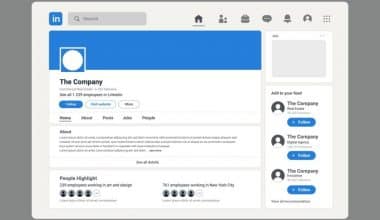Podcast monitoring is a key indicator of a podcast’s success. Data is essential for guiding strategies, making strategic decisions, and monitoring return on investment (ROI). Understanding how to monitor podcast metrics and data can help you make informed decisions regarding your podcasting efforts.
The keyword here is “confirmation.” Has creating and publishing a podcast been a worthwhile investment of your time?
From a personal standpoint, that may well be the case. You might feel a great sense of achievement with the final product. However, if the purpose of your podcast is to create brand awareness or increase lead generation, you need an objective viewpoint to guide you. Monitor podcast stats to confirm in no uncertain terms whether or not your time has been well spent. This article will discuss podcast monitoring and the best tools to make the work easier for you.
Key Points
- Podcast monitoring is a subset of media monitoring that monitors what the media says about a particular topic.
- There are several unforeseen advantages to podcast monitoring that all brands should consider, such as trend research, influencer identification, campaign measurement and optimization, and brand monitoring.
- Podcast Monitoring Methods include Finding and following podcast creators, following industry trends, and tracking keyword mentions.
- 5 podcast monitoring tools I implore you to try in 2024: Meltwater, Critical Mention, Brand24, Podtrac, and Podbean.
- To choose the right tools for your podcast, consider the following to help you decide: level of experience, budget, and show format.
What Are Podcast Monitoring?

Podcast monitoring is a subset of media monitoring that monitors what the media says about a particular topic. Brands are increasingly leveraging multiple channels to expand their interaction with consumers. However, innovative brands can only keep conversations alive using the right platforms to gather insights. Visuals and text aren’t the only mediums for them; they also use audio for maximum benefit.
The concept of podcasting is becoming more popular every year. This year, statistics have shown that approximately 75% of people around the US are familiar with podcasts, and the percentage is steadily increasing.
However, just marketing through podcasts is not enough. To gain real insight into the response of your target audiences, you need to monitor it—which is where podcast monitoring comes in.
Audio-based platforms and podcasts are growing in popularity. They can be a significant source of entertainment and news. This is because they hold extensive amounts of information that businesses should not ignore when capturing their consumers’ voices. Here are some ways podcast monitoring can be added to your social media strategy—and how it works.
How Podcasting Monitoring Can Be Used To Your Advantage
It is a given how critical social media and the internet, in general, are when marketing your brand. You should leverage all mediums, from text-based posts to audio-based podcasts. In addition, there are several unforeseen advantages to podcast monitoring that all brands should consider, such as:
#1. Trend Research – Discover New Markets and Opportunities
Podcasts are a favorite way to discover new products, ideas, and trends. New ideas make for great conversation, and podcast hosts are known to mine the bleeding edge of what’s new and trendy for podcast fodder.
There’s also a lot of podcasts out there.
If you’re considering placing an ad buy in a podcast, you’ll need a massive budget or next-level targeting and filtering.
Let’s say you’re a fintech app; maybe your product helps businesses re-invest. You have a specific goal your product accomplishes, and putting an ad on the Joe Rogan Experience isn’t going to move the needle.
Here, we’re comparing podcasts discussing finance to podcasts discussing innovation in finance for two weeks in early February.
By determining your next level of filtering within a broader query, you can quickly identify the half dozen or so podcasts that speak to exactly the type of audience you’re after. Once identified, you can learn what motivates them, the broad themes of their discussions, and topics your ad can mimic to help make it more impactful.
#2. Influencer Identification – Find New, Influential Fans Already Talking About Your Brand
Speaking of influence, let’s talk about finding your brand’s fans. Not just fans, but your mega-fans, with mega-reach in a narrow niche.
Looking at the overall video game console ecosystem, as mentioned on podcasts, we can see the mentions are fairly evenly distributed amongst the three big consoles over time.
Digging into this a bit deeper, we discovered one podcast, Nintendo Switch Craft, which discusses the Nintendo Switch and has had incredible community reactions. This podcaster consistently releases episodes and entirely focuses on the Switch and its games. By standard metrics, he is a micro-influencer and maybe wouldn’t appear on an influencer or public relations agency rosters or use traditional influencer I.D. tools.
He has fewer than 5,000 followers across Twitter and Twitch, but they are extremely engaged and passionate about his content:
Checking the demographic data allows us to validate what our gut tells us from a brand marketing perspective—this is a legitimate influencer with a happy and engaged audience. Advertising with this influencer is a safe plan from the brand’s perspective and will likely succeed.
The influencer’s followers are primarily in the United States. They are outsized video-game fans, and 73% are in the 25-44 age bracket, which means they have some disposable income.
#3. Campaign Measurement and Optimization – Get a 360° View of Your Industry
Perhaps most important for any business is knowing what’s happening in its industry. That’s why trade magazines and industry groups exist. Keeping tabs on the industry is part competitive monitoring and part inspiration-seeking.
Let’s peek at an industry that’s seen explosive growth in the last couple of years: the plant-based meat alternatives industry.
We can see that it’s Beyond Meat and everyone else.
We can see that Beyond Meat captures an outsized proportion of the mentions. This includes visual mentions, where a brand logo is visible in a photo or video included in a post.
That’s one way to look at a post, but another common way for people to communicate is with emojis, and here, too, we can see some notable trends.
Predictably, we have foods represented in the emoji cloud, but there’s also a lot of green for a group of Unicode characters that are disproportionately yellow. If you want to add flair to social posts about meat alternatives, this is something to note.
Digging deeper into the emojis used, we might uncover some niche podcasts that discuss vegan recipes or similar topics and primarily use the 🟩 square emoji to promote themselves.
#4. Brand Monitoring
Utilize podcast monitoring to extract hidden brand mentions. Having complete visibility into the conversations taking place around your brand can help you prepare future PR campaigns and communication. Gathering insights through podcast monitoring can boost your ROI and protect your brand.
You do not have to guess what podcasts discuss your industry or wait for organic mentions about your brand. Podcast monitoring gets you all relevant information from many podcasts in seconds, meaning you do not have to stream through hours and hours of audio to find brand mentions.
Read also: What is Brand Monitoring, and Why Is It Important For Your Business?
Podcast Monitoring Methods
Here are some of podcast monitoring methods:
#1. Find and Follow Podcast Creators
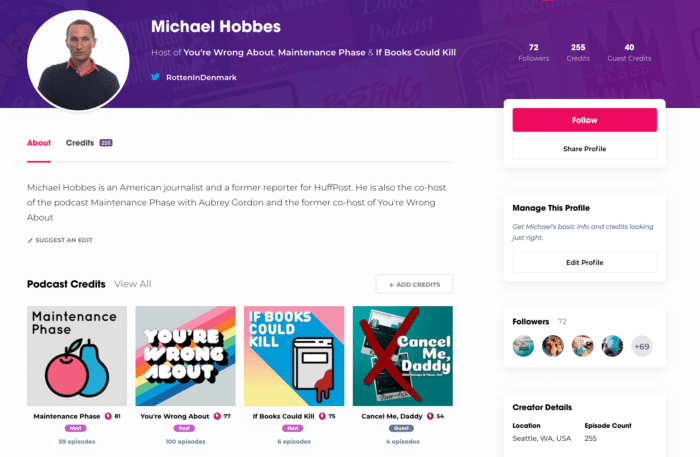
To go beyond finding podcasts discussing your topics of interest, find and follow podcast creators on Podchaser. That way, you are alerted when those creators post their own content and when they guest on other podcasts.
Following creators’ guest appearances gives you insight into what an influencer says about your niche. It also helps you discover the show’s creators are guesting on, giving you more ideas on which podcasts to monitor.
But how do you find these creators in the first place? With the world’s most comprehensive podcast database, Podchaser. The perfect creators and podcasts you can monitor are just a few clicks away on Podchaser. AND Podchaser Pro unlocks access to even more one-of-a-kind podcast data (more on that at the end of the article).
And the benefits of finding relevant creators don’t end at podcast monitoring. If you find creators who are a perfect fit with your brand, you could even recruit them to be influencers for your brand.
#2. Follow Industry Trends
Finding the creators and podcasts you’re interested in is only the first step. The next is actually listening. Pay attention to what these influencers discuss about industry trends. Where is it going, and what trends are they tired of? Understanding these conversations provides a deeper understanding of your future priorities and inspires innovative ideas.
Podchaser’s lists are a handy way to keep track of podcasts you’re monitoring. Once you’ve found a show you’re interested in, add it to a list. Then, later, you’ll have all your research in one handy spot.
Lists are also a unique method to find podcasts within your niche to monitor. Podchaser users are rabid fans and have likely already compiled the best podcasts on a certain topic into a Podchaser list, whether that be crypto, fantasy baseball, or anything else!
#3. Track Keyword Mentions
The downside of the previous two methods is their time-intensiveness. To properly monitor everything, you must find creators and actively listen to hours of podcasts.
For instance, at Podchaser, they wanted to give PR firms, D2C brands, and other podcast professionals a way to monitor podcasts that wouldn’t take up all your time. So, they created Podchaser Alerts. Podchaser users can set alerts for any target keyphrase and then receive daily alerts when that keyphrase is mentioned.
The podcast monitoring uses of Alerts is myriad:
- Track mentions of specific people: Discover who’s talking about you, your client, or someone you’re interested in. Best when used for mentions. They’ve already got you covered if you’re looking to track credits.
- Analyze topics and trends: Create an alert with the search phrase of the topic you want to track. You’ll receive a daily email update with all the episodes discussing that subject.
- Brand mention tracking allows you to see how a brand or product is being talked about by podcast influencers. This is perfect for understanding brand positioning and measuring the impact of campaigns.
What Is the Primary Purpose of a Podcast?
People may want to start a podcast for several reasons. Maybe someone is an enthusiast about a certain topic, wanting to develop and share their knowledge. Most podcasts are started as passion projects. When someone loves a specific topic person or just sees this as an opportunity to share, they’ll start a podcast.
Most people use this platform because it’s cheap to start, and you don’t need many tools or equipment immediately. Alternatively, someone could use a podcast for marketing potential and see it as a direct way to sell to customers.
Podcasts are a great marketing tool for many reasons. They create a repetitive touchpoint for your customers. Whether you’re selling a specific product or using the podcast as a platform to sell multiple items, it can work wonders for your sales. And, according to Forbes, podcasts are more popular than Catholicism!
The benefits don’t stop there, either. With so many different podcasts available, you can use this to really target your ideal audience. We don’t see this trend slowing down anytime soon.
Why It’s Important to Monitor Podcast Metrics
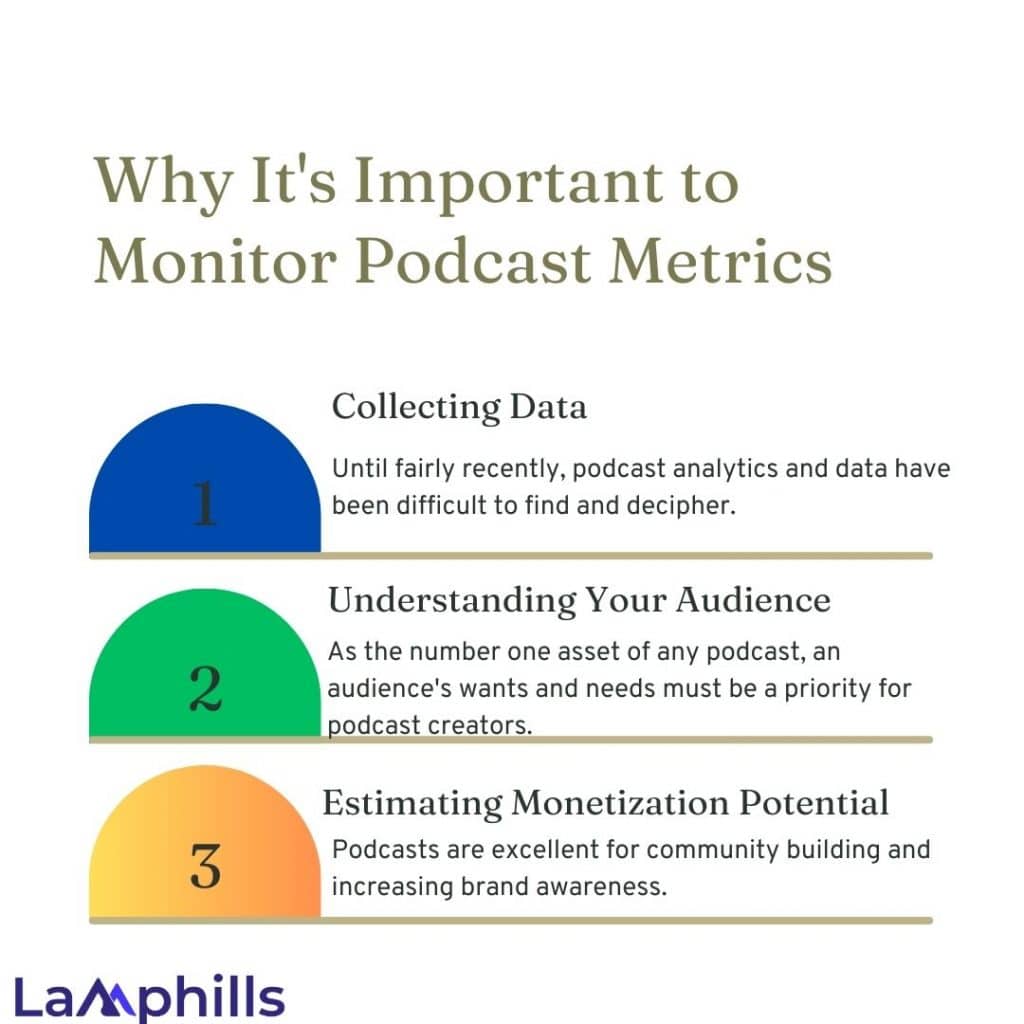
Tracking data and insights is an integral part of any marketing effort. With good data, you can see what’s working and what isn’t. Analytics enable you to gain deeper insight into what’s resonating with your audience, which in turn helps you create more meaningful and valuable content.
This applies to paid advertising and organic marketing (SEO, etc.). Analytics and data drive all of these efforts and determine spending and strategy.
#1. Collecting Data
Measuring your podcast data allows you to:
- Monitor your listener base, streams, downloads, and subscriptions to see how much they have increased or decreased.
- Adjust your content or episode release schedule according to listener numbers, reviews, and engagement.
- Sift through your content to identify quality issues and rectify them accordingly.
- Create highly targeted ads to monetize your podcast using listener demographics, device, and location data.
- Use your actual, real-time listener data to help market yourself to paid-ad sponsors or podcast networks.
- Assess if you should create additional value through transcripts, videos, or repurposed content.
- Bolster marketing campaigns by utilizing your positive reviews.
Until fairly recently, podcast analytics and data have been difficult to find and decipher. By looking across the proper channels, you can track the podcast stats required to gain insights into your audience and your overall ROI.
Podcast metrics can include how many listens a downloaded episode gets, how many listeners a podcast has per episode, how long people listen to specific episodes, and more. Populating your reports with the relevant numbers is no longer the headache it once was. This is especially beneficial for marketers who must highlight their efforts to relevant stakeholders.
#2. Understanding Your Audience
As the number one asset of any podcast, an audience’s wants and needs must be a priority for podcast creators. Podcast monitoring and analytics help you better understand your listeners’ interests and habits, enabling you to align your content and podcast marketing strategies accordingly.
Podcast analytics reveal everything from the number of listeners, their location, and the time they listen to the devices used for listening, listening duration, and even the stopping point and highest-ranked episodes.
With so much helpful information at your fingertips, it is much easier to develop podcast ideas that resonate with your audience and are more likely to gain traction.
#3. Estimating Monetization Potential
Podcasts are excellent for community building and increasing brand awareness. As your audience grows, so does the potential to begin monetizing your podcast.
Analytics tell target sponsors how popular a podcast is, which is often the defining factor for whether or not they want to partner with you.
The podcast metrics on Spotify, Apple Podcasts, and Google Play are also helpful. These platforms can provide relevant audience demographics, such as countries/regions they’re listening from, age ranges, gender, careers, and yearly income. Gathering this information can give you enough scope to refine your sponsor options.
How Do You Measure Podcast Success?
Measuring the success of a podcast involves evaluating various metrics and aspects that reflect both quantitative and qualitative outcomes. Here’s a comprehensive checklist guide to help you measure podcast success effectively:
How to Measure Podcast Success Checklist
5 Top Podcast Monitoring Tools You Should Use in 2024
There are more than 3 million podcasts on all podcast hosting platforms, and over 50 million podcast episodes have been created by now. The number of podcast listeners is expected to reach more than 400 million in 2024. This medium is taking over the world. That’s why you need podcast monitoring tools!
The above numbers speak for themselves! There are more and more podcast listeners, and many people are starting to host their podcasts. New podcasts spring up every day! Podcasting has become a new hobby for many. A professional studio is not needed at all. Everyone, as long as they have access to a reasonably good microphone and a space where it’s quiet, can do it.
So, there’s a high probability that your brand will be mentioned in a podcast episode, and it doesn’t necessarily have to be a podcast that you know exists. Imagine having to listen to many podcasts every day to check if there are hidden mentions. No matter what, it’s impossible!
You can track mentions in podcast episodes without wasting your precious time listening to them from the beginning to the end!
Of course, you have no control over what podcasters say about your brand, product, or service, so keeping an eye on it pays off. In other words, use podcast monitoring tools and protect your brand’s reputation. Here are the top 5 podcast monitoring tools I implore you to try out in 2024:
#1. Meltwater
Meltwater is a professional, all-in-one solution. It combines media monitoring, listening, and social media engagement. One of the media monitoring in this tool is podcasts.
It tracks over 25,000 podcasts on platforms such as Spotify, Apple Podcasts, and Google Podcasts. Additionally, there is an option to add podcasts to the capture network if desired podcasts are not covered.
The significant disadvantage of Meltwater is its price. The cost to use the tool is at least $8,000 per year. Due to this, large companies generally use this podcast monitoring tool.
Key features:
- Mentions tracking
- Dashboard with customizable metrics.
- Developed insights reports
- Customized newsletters used for distribution
- Database of media contacts (+450,000 contacts)
- External software integration
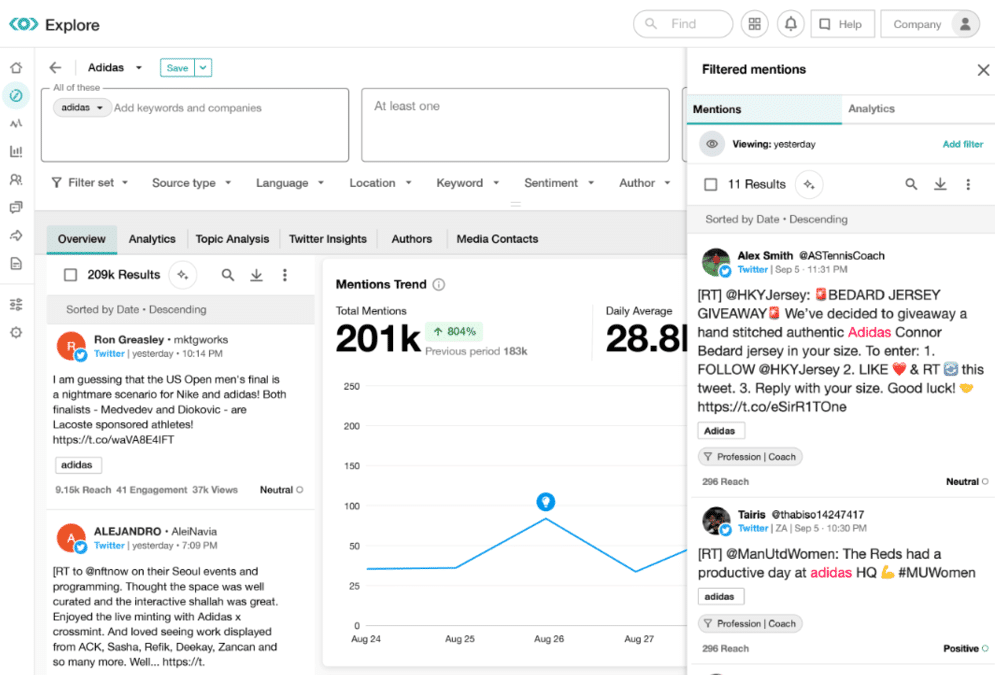
#2. Critical Mention
Critical Mention is an easy-to-use media monitoring tool, including offline, online, and social media. It’s targeted more at PR professionals than marketers since it covers radio and TV.
Critical Mention has interesting features related to podcast monitoring. It searches keywords in audio-based clips and transcripts, and thanks to the Wordplay tool, users can edit podcasts to capture the exact mention.
Regarding its price, Critical Mention is not transparent. They said they tailor the offer to the customer and his requirements.
The big drawback of this tool is that it doesn’t offer any metrics useful for influencer marketing and doesn’t have a mobile app. On top of that, their dashboard looks very simple, as if it has stayed the same since 2002 (FYI, Critical Mention was founded in 2002). This may not be a problem for some users, but it bothers me.
Key features:
- Brand mentions tracking
- Keyword tracking
- Wordplay tool
- Customized reports with valuable insights
- Media contact database (+1,000,000 contacts, including influencers)
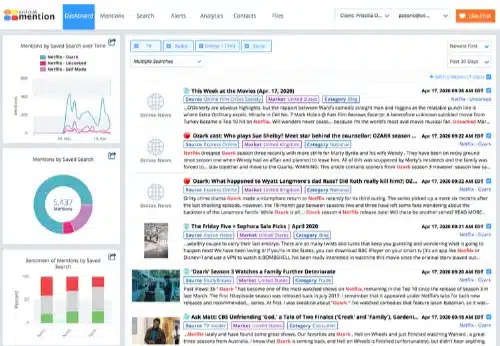
#3. Brand24
Brand24 is a powerful AI social listening tool. It tracks mentions of hashtags, keywords, brands, and product names across all public sources in real-time. These sources are (of course) podcasts, the most important social media (Instagram, X (Twitter), Facebook, Reddit, LinkedIn, Quora, YouTube, TikTok, Telegram, Twitch), news, blogs, videos, forums, and much more!
Thanks to real-time alerts, users can directly jump into the conversation about their products or brands and take appropriate action.
Brand24 does everything for you! You get neat and brandable reports with tons of data and gather insights.
Brand24 is the first tool on the market to track mentions across audio-based platforms. It collects data from major platforms such as Spotify, Apple Podcasts, Google Podcasts, Soundcloud, Spreaker, and Libsyn, as well as from smaller ones.
Brand24 has a very user-friendly dashboard. To check the mentions in the podcasts, you just have to tick podcasts as a source in your project. You’ll get a complete list and a line chart representing the number of mentions and reach over a selected period.
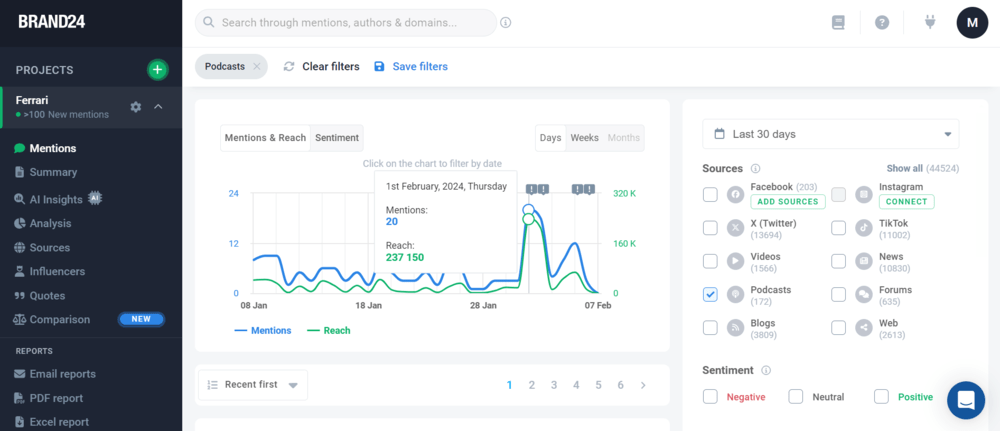
It’s visible in the real-life example of the keyword Ferrari. Ferrari recorded a spike in mentions on January 1, 2024. With 20 mentions in podcasts, it generated a reach of 237,150.
Free 14-day trial.
#4. Podtrac
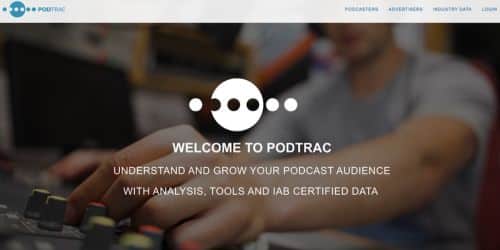
Podtrac is a podcast analytics platform designed to help creators understand and grow their audience. Serving podcasters, advertisers, agencies, and industry professionals, Podtrac is a widely trusted advanced podcast analytics tool.
Price: Podtrac has a free plan and a “Grow your Show” plan available for $20/month
Features:
- Podcast traffic measurement: Podtrac’s tools cater to various needs regarding show growth and performance tracking. Users can monitor day-to-day growth through the Key Metrics report, gain quick insights into overall performance, and delve into detailed daily episode-level download data.
- Podcast audience demographics: Podtrac’s demographic survey enables the collection of numerous insightful data points about the audience. This data is then conveniently displayed on the user’s dashboard, providing valuable insights into the demographics of podcast listeners.
- Podcast rankings: Podtrac offers two free monthly Podcast Industry Rankings: the Top 20 Podcasts and the Top 20 Podcast Publishers. Additionally, users can purchase rankings of top podcasts by category.
#5. Podbean
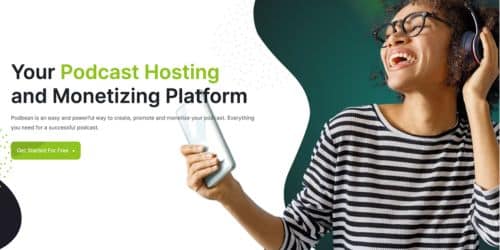
Podbean is another popular podcast hosting, monetization, and analytics platform. It provides podcast performance insights such as listeners, downloads, followers, comments, and likes. Podbean also offers data about your audience, such as where they live and what apps they use to access your content.
Price: Free – enterprise plans available
Features:
- Top 10 Episodes: Podbean compiles download data and highlights the top 10 episodes for different periods. This feature allows podcasters to identify their most popular content and discern patterns that could help expand their listener base.
- Listener geographies: Podbean provides a geographic breakdown of where listeners are located to help you tailor content and target sponsors more effectively.
- Downloads by time of day: Podbean tracks when episodes are downloaded the most, showing podcasters the best days and times to release new content.
- User retention: Podbean provides insights into user retention, showing how well the podcast has retained listeners over recent weeks. This data is presented in a graph, highlighting the attractiveness and stickiness of podcast content.
How to Choose the Right Tools for Your Podcast
It’s easy to get overwhelmed by all the tools, apps, and equipment designed to help you make a podcast. But not every choice is right, especially if you’re just starting. Take the following into consideration to help you make your decision:
- Level of Experience: Are you a beginner who isn’t very tech-savvy? You may want to start with the basics, like all-in-one recording and editing software and a full-service hosting service like Podbean, to help you get started in distribution and promotion.
- Budget: How much money do you have to spend? Large teams or corporate podcasts may want to hire a podcast agency and invest in tricked-out camera equipment, while solo creators on a tight budget may prefer D.I.Y. social media scheduling tools and a high-quality webcam.
- Show Format: What kind of podcast are you producing? For instance, An interview podcast requires fewer production tools than an audio-drama narrative podcast. Start with the minimum of what you think your show will require, and you can always add more as necessary.
How Do I Get People to Listen to My Podcast?
Not sure how to increase your podcast listeners? Then you’re in the right place. Because after all that time and effort researching and recording, you need to know how to grow your podcast, too.
So, to help increase your podcast listeners, below are six crucial tips to help people find you.
#1. Create a Podcast trailer
A podcast trailer is a snapshot of your show, giving potential listeners a taste of what to expect. Think of it as the hook that can lure an audience into the world you’ve created.
To craft a captivating trailer, focus on distilling the essence of your podcast into a brief, engaging audio clip, typically between 30 seconds to a minute. Highlight the themes, the tone, and what sets your podcast apart.
Ensure the trailer is accessible on your podcast’s landing page and share it across your social media platforms to generate interest and anticipation.
#2. Use Calls to Action
A call to action is a crucial tool in your podcasting arsenal. It guides your listeners to take action, such as subscribing, leaving a review, or sharing your podcast on social media.
The key to an effective CTA is clarity and urgency. Be specific about what you want your listeners to do and make the action simple and quick.
Embed your CTAs naturally within the content, ensuring they resonate with your audience and add value to their listening experience. To prevent listeners from getting confused about what action to take, only use one CTA at the end of each episode.
#3. Promote Your Podcast on Social Media
Social media platforms are invaluable for promoting your podcast and engaging with your audience. Each platform has unique features and audience preferences, so tailor your content accordingly.
Share behind-the-scenes glimpses, episode snippets, or engaging visuals that reflect your podcast’s theme. Use hashtags strategically to increase your content’s reach and engage in conversations with your listeners to build a community around your podcast.
Audiograms are a great way to promote your podcast and attract new listeners. Don’t know what one is? It’s the short part of your podcast turned into a video you can share on social media.
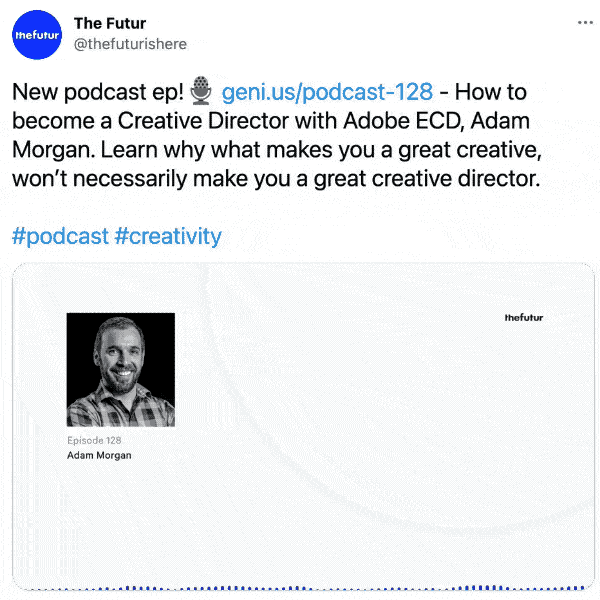
If you don’t know how to make audiograms, reel.so has you covered. With just a few clicks, you can promote your podcast on social media with beautifully designed audiograms with no design skills needed.
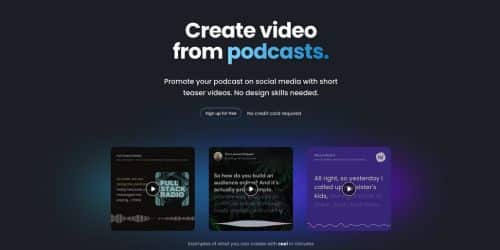
Additionally, consider leveraging paid advertising to target potential listeners based on their interests and listening habits.
#4. Creating and Repurposing Content
Repurposing your podcast content can significantly extend its reach and appeal to different audience segments. Transforming a single episode into multiple content pieces, such as blog posts, quotes, infographics, or short video clips, can maximize your content’s exposure.
This helps attract listeners who prefer different media formats and reinforces your podcast’s online presence.
Consider writing a corresponding blog post for each podcast episode, or transcribe your podcast and convert the transcript into a blog post. Written content is needed to improve the searchability and ranking of your podcast. That’s because Google finds text easier to crawl than audio.
Also, don’t forget to repurpose previous episodes. Just because it’s done and dusted doesn’t mean it’s not still relevant. That one you did two years ago may be just what someone needs to hear now.
Want to grow your mailing list for email marketing purposes? Then, repurpose previous episodes into downloadable content. Create infographics, checklists and more. Your listeners must give you their email address to download this valuable info. So, make sure they offer good value, help people to solve problems, or enable them to take action.
#5. Podcast SEO
Search Engine Optimisation (SEO) isn’t just for websites; it’s equally crucial for podcasts. By optimizing your podcast’s title, descriptions, and show notes with relevant keywords, you enhance its visibility on podcast directories and search engines.
Conduct keyword research to identify terms your target audience is searching for and incorporate them naturally into your content. Additionally, encourage listeners to leave ratings and reviews, as these can improve your podcast’s ranking and credibility.
#6. Invite Guests and Star as a Guest on Other Podcasts
Featuring guests on your podcast and guesting on others can significantly broaden your listener base. Collaborations introduce your podcast to new audiences and add varied perspectives and expertise to your content.
When selecting guests or podcasts to collaborate with, ensure alignment in values, content, and audience demographics. Effective networking and building genuine relationships within the podcasting community can lead to more collaborative opportunities and mutual growth.
A guest provides double the promotional opportunities. Your separate social media platforms and individual marketing activities will help you reach a wider audience.
Better still, guests introduce you to their audience, a brand-new bunch of people, providing you with more podcast listeners.
Bottom Line
Podcasts are increasingly popular, so implementing podcast monitoring provides full coverage of what’s being said about brands. If you’re not already monitoring podcasts, you should start doing it.
By monitoring podcasts, you can:
- Gather insights into what people say about your brand and your competitors
- Explore potential influencers in the industry to collaborate with
- Discover new target audiences and market opportunities
Shortly speaking, seeing podcast data next to other sources gives a complete picture of the marketing efforts.
Similar Articles
- The Power of Brand Monitoring Software: Unlocking Consumer Insights
- 15+ Public Relations Tools That Work: A Personal Guide to Enhancing Your PR Strategy
- The Role and Importance of Social Media in Public Relations

